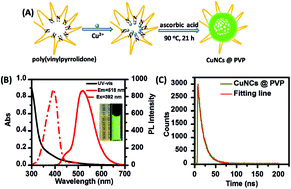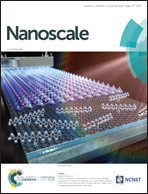PVP-templated highly luminescent copper nanoclusters for sensing trinitrophenol and living cell imaging†
Abstract
Copper nanoclusters (CuNCs) exhibit susceptibility to oxidation in the subnanometer size range. In this work, a facile and green protocol is reported for the successful synthesis of water soluble CuNCs, with poly(vinylpyrrolidone) as a template and ascorbic acid as a mild reducing agent. The as-prepared CuNCs exhibit a green fluorescence and high quantum yield (QY = 44.67%) in water, which is the highest among the reported water soluble CuNCs. The origin of their highly luminescent nature was also investigated. In addition, the obtained CuNCs show good tolerability to high ionic strength, superior antioxidation properties, good photostability, time-stability, a large Stokes shift and ultralow cytotoxicity, laying the foundation for living cell imaging in THP-1 macrophages. A bright green fluorescence can be observed from the cells, indicating the potential practicality of CuNCs as a fluorescence marker in bioapplications. Interestingly, the as-prepared CuNCs exhibit a good selective fluorescence quenching response towards trinitrophenol over other nitro compounds. Furthermore, CuNCs were employed for sensing trinitrophenol based on the inner filter effect. A good linear relationship was obtained in the low concentration range of trinitrophenol, with a limit of detection of 3.91 × 10−7 M in aqueous medium. This result suggests the potential application of CuNCs as a probe in sensing and monitoring toxic trinitrophenol in the field of environmental security.



 Please wait while we load your content...
Please wait while we load your content...